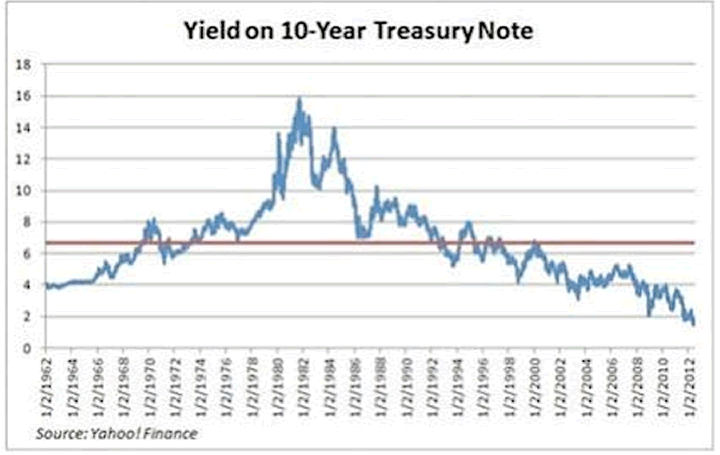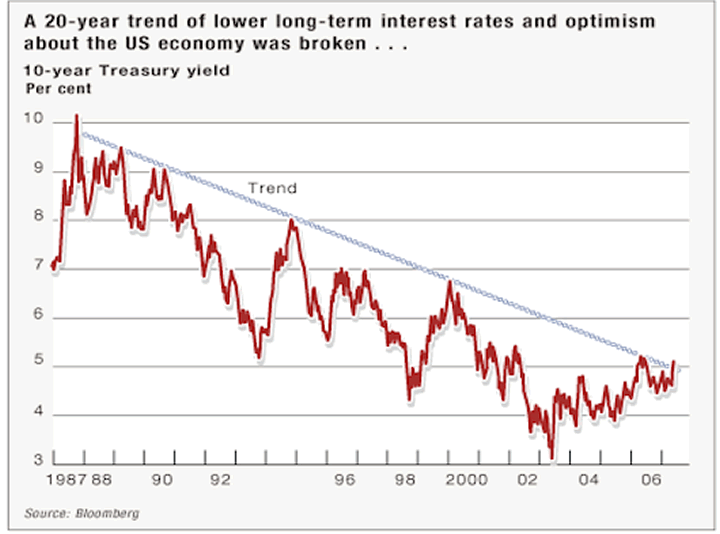Have Interest Rates Finally Bottomed?
Interest-Rates / US Interest Rates Nov 29, 2012 - 02:46 AM GMTBy: Submissions
 Timothy Lutts writes: The media in recent weeks have been full of stories about the coming Fiscal Cliff. No one knows exactly how Congress is going to deal with it, but one fairly common opinion is that taxes will go up on investment income.
Timothy Lutts writes: The media in recent weeks have been full of stories about the coming Fiscal Cliff. No one knows exactly how Congress is going to deal with it, but one fairly common opinion is that taxes will go up on investment income.
As a result, many smart people have been making moves to take income now rather than in 2013 (or later.)
Wal-Mart joined retailers Hot Topic and Buckle in shifting its January dividend to December. Leggett and Platt Wynn Resorts are among the dozens of companies doing the same.
But dividend-shifting by companies is only the most obvious move.
Much bigger but less quantifiable are the numbers of investors selling their dividend-paying stocks because they’re afraid that higher tax rates on capital gains will make holding them financially unwise. The number appears to be substantial, given the market’s decline since the election, especially in income-heavy stocks like utilities.
Now, most investors try to examine this flight from dividends from a purely rational, fundamental point of view, and that’s hard to do when a key part of the equation—next year’s tax rate on dividends—is unknown.
I like to add a technical component as well, starting with this chart.

As most of us know now, interest rates have been declining for roughly 32 years—and those 32 years have brought a sea change in attitudes.
Remember back in 1980, when bonds were yielding double-digits?
Were investors clamoring to buy bonds then?
No, because they were afraid inflation, which was rampant, would wipe out their income. So they rushed to buy gold and silver instead—causing gold and silver prices to peak.
Yet the contrarians who bought those bonds in 1980 and locked them away did very well indeed, as inflation gradually subsided.
The message—useful in viewing any kind of free market—is that the “crowded trade,” which typically feels comfortable and seems rational, eventually turns out to be exactly the wrong trade.
Which brings us to today.
As we all know, recent years have seen bond yields driven into the basement, as investors withdrew from volatile equity markets. The collapse of the housing market helped, too.
This tremendous appetite for safety has resulted in a very crowded bond market.
And that tells me that eventually, when this 32-year downtrend in interest rates ends, and interest rates revert back towards their long-run average of 6.7%, bond investors will see their principal evaporate faster than a snowball in July.
It’s been a very long time since that happened. More than 32 years. Many bond investors alive today have no idea how fast their money can disappear as interest rates rise.
Many of them will learn the hard way—eventually.
Now, let me be perfectly clear. While I do know that rates will turn up sometime, I’m not saying that rates have turned up yet. Though it’s tempting to say that higher taxes on dividends—courtesy of the Fiscal Cliff—will be the straw that breaks the camel’s back, I simply don’t know.
I also know it’s foolish to predict.
Consider the chart below from a June 2007 issue of European Tribune declaring the end of the downtrend in interest rates.

Hindsight tells us that was a premature declaration—by more than five years!
So what should you do?
My advice is simple. Look for the uncrowded trade. Search for the unadvertised bargains.
For example, over the Thanksgiving holiday, I spoke with many friends and even more relatives, and none of them mentioned a single stock by name!
They didn’t mention aggressive stocks like Facebook, which flopped this year, or Apple, which is down 19% from its high.
And they didn’t mention conservative stocks, even though many of them boast yields far better than you can get in a bank!
I think the best of these stocks are screaming buys here—though no one is advertising that, so that’s what I’m going to do today.
The stock I want to highlight is Bank of Montreal (BMO). It’s Canada’s oldest bank, and one of the Big Five banks in Canada. Its stock is traded on the NYSE, and it yields 4.9%.
Here’s what Roy Ward, editor of Cabot Benjamin Graham Value Letter, wrote about it recently.
“Founded in 1817 in Montreal, Bank of Montreal provides a wide range of retail banking, wealth management and investment banking services in North America. The bank also provides an array of credit and non-credit products and services. The bank maintains 1,600 branches in Canada and the U.S., and operates internationally in major financial markets and trading areas throughout most of the world. Bank of Montreal has made three major acquisitions during the past three years.
“Marshall & Ilsley (M&I) of Wisconsin was purchased in July 2011 for $4.2 billion. BMO paid a very reasonable price, but M&I's loan portfolio includes some non-performing loans. Bank of Montreal folded M&I Bank into its Harris Bank division (based in Chicago). In 2009, Bank of Montreal acquired Diners Club North America from Citigroup for $1.0 billion cash. In 2009, it acquired AIG's Canadian Life and Health Insurance unit for $375 million in cash.
“Revenues climbed 12% and earnings per share (EPS) increased 13% during the 12 months ended 9/30/12. I expect revenues to advance 2% and earnings to increase 6% during the next 12-month period, although Marshall & Ilsley's better-than-expected performance could boost revenues and earnings noticeably higher. Remarkably, BMO has been paying dividends since 1829. The dividend was recently raised for the first time in five years and now provides a high 4.9% yield. At 9.5 times my forward 12-month EPS forecast of 6.29, Bank of Montreal shares are undervalued. BMO is governed by the strict Canadian banking regulations and is low risk.”
It makes perfect sense to me, and I hope it does to you, too. Furthermore, I hope it helps you understand that equities truly are the uncrowded trade today, with unadvertised bargains galore.
How else can you explain the fact that government bonds are so popular, even though rates are in the basement and rising rates would be devastating to investors’ principle, while high-quality stocks like Bank of Montreal—whose dividends are much more secure—are available for bargain prices?
Now, you could agree with all this and simply buy some BMO, but what I recommend is a no-risk trial subscription to Cabot Benjamin Graham Value Letter, so that you can get regular follow-ups on BMO, as well as advice on investing in similar undervalued stocks.
Over the past 10 years, the Letter’s Classic Model has achieved a total return, not including dividends, of 185.6% compared to a return of just 47.3% for the Dow Jones Industrial Average. And I think even better performance is on the way.
For details, click here.
Yours in pursuit of wisdom and wealth,
Timothy Lutts
President, Chief Investment Strategist, Editor of Cabot Stock of the Month
Timothy Lutts heads Cabot Heritage, one of America’s most respected independent investment advisory services, publishing 12 newsletters including the Cabot Benjamin Graham Value Letter to more than 250,000 subscribers around the world. Combining time-tested investing systems with expert editorial content, these newsletters serve not only to make readers richer investors but to make them better investors. Under Tim's leadership, Cabot has been honored numerous times by Timer Digest, Hulbert Financial Digest and the Specialized Information Publishers Association as among the top investment newsletters in the industry. Tim also edits Cabot Stock of the Month Report.
© 2012 Copyright Timothy Lutts - All Rights Reserved
Disclaimer: The above is a matter of opinion provided for general information purposes only and is not intended as investment advice. Information and analysis above are derived from sources and utilising methods believed to be reliable, but we cannot accept responsibility for any losses you may incur as a result of this analysis. Individuals should consult with their personal financial advisors.
© 2005-2022 http://www.MarketOracle.co.uk - The Market Oracle is a FREE Daily Financial Markets Analysis & Forecasting online publication.



